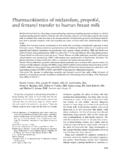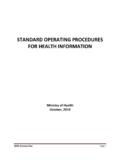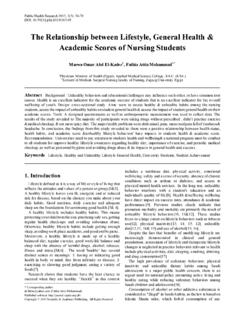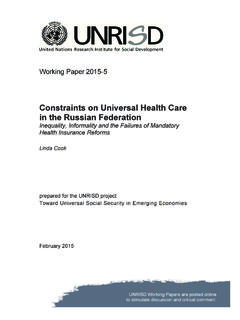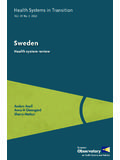Transcription of Birth defects in Singapore: 1994 - 2000 - Anesthesia
1 singapore Med J 2005; 46(10) : 545 Original ArticleDepartment ofMaternal FoetalMedicineDivision of Obstetrics& GynaecologyKK Women s &Children s Hospital100 BukitTimah RoadSingapore 229899K H Tan, MMed,FRCOG, FAMSS enior ConsultantT Y T Tan,MMed, MRCOG,MRANZCOGA ssociate ConsultantJ Tan, MBBS,MRCOGA ssociate ConsultantG S H Yeo, MBBS,FRCOG, FAMSS enior Consultantand HeadChairman,Division of Obstetrics& GynaecologyNational BirthDefects RegistryMinistry of HealthI Tan, BScStatistical OfficerEpidemiology andDisease ControlMinistry of HealthS K Chew,MBBS, MScDeputy Director ofMedical ServicesCorrespondence to:Dr Kelvin Tan Kok HianTel: (65) 6394 1323 Fax: (65) 6394 1017 Email: defects in singapore : 1994 - 2000K H Tan, T Y T Tan, J Tan, I Tan, S K Chew, G S H YeoABSTRACTI ntroduction: To study characteristics of birthdefect cases among live births, stillbirths andabortions in singapore between 1994 and : Index cases for the National BirthDefects Registry (NBDR) were obtained fromall neonatal nurseries in singapore , all hospitaldischarge summaries, cytogenetic and pathologyreports from all pathology laboratories inSingapore, and from the compulsory reporting ofall termination of pregnancy cases and stillbirthsdelivered.
2 Further information was obtainedfrom case notes retrieved from the medical recordoffices, antenatal clinics, cytogenetic laboratories,pathology departments and the Registry ofBirths and Deaths. The notified cases (live births,stillbirths and abortions) between 1994 and2000 were extracted from the NBDR andanalysed with regard to ethnicity, maternalage, trend over the seven years and types of birthdefects using the British Paediatric : Between 1994 and 2000 , a total of 7,870cases (6,278 births and 1,592 abortuses) werenotified, giving a rate of Birth defect casesper 1000 live births. There was a decreasing trendin Birth defect incidence ( to per 1,000live births) among live births and stillbirths andan increasing trend of abortion ( to per1,000 live births) for Birth defects .
3 Malays hada higher rate of congenital defects at Birth ( ,000 live births) compared to Chinese( ,000 births). The 25-29 years age grouphad the lowest overall rate ( ,000 live births)compared to the 19 years and below group ,000 live births and the 45-49 years groupat ,000 live births. The five most commongroups of anomalies (per 1,000 live births) werethose of heart ( ), musculoskeletal ( ),chromosomal ( ), urinary ( ) and nervoussystems ( ). The five most common abortedanomalies (per 1,000 live births) were those ofchromosomal ( ), nervous ( ), heart ( ),musculoskeletal ( ) and urinary systems( ).Conclusion: There was an increasing trend ofabortion for Birth defects , accompanied by afalling trend in the congenital anomalies of livebirths.
4 Both extremes of maternal age wereat higher risk of non-chromosomal Birth defectswhile advanced maternal age was at higher riskof chromosomal : abortion, Birth defect, chromosomedisorders, congenital abnormalitiesSingapore Med J 2005; 46(10):545-552 INTRODUCTIONC ongenital Birth defects have now become a majorcause of perinatal and infant morbidity and mortalityin singapore . The National Birth defects Registry(NBDR) was set up by the Ministry of Health onJanuary 1, 1993 to gather data on congenital birthdefects in singapore . The registry collates informationon a national scale and helps to facilitate theplanning and evaluation of antenatal screening,genetic counselling and paediatric medical andsurgical services.
5 Since February 1, 1999, NBDR wastransferred to and based at the KK Women s andChildren s Hospital (KKH). This paper aims tostudy characteristics of Birth defects cases amonglive births, stillbirths and abortions in Singaporebetween 1994 and method of data collection of NBDR haspreviously been described(1). To summarise, datacollection was based on multiple sources comprisinggovernment bodies, public and private medicalcentres. These included the Health Regulation (HR)Division and the Epidemiology & Disease Control(E&DC) Division of the Ministry of Health, theNational Registry of Births and Deaths (RBD) singapore Med J 2005; 46(10) : 546as well as the cytogenetic laboratories, histologylaboratories and nursery wards in system of double-reporting ensured that under-ascertainment was minimised.
6 To ensure a highquality of information provided to the registry,field visits were made by the NBDR staff forany Birth defect registration with incomplete,inconsistent and uncertain information. Carewas taken to ensure that requirements for theprotection of personal data were fully measures were in place to ensure confidentialityof data and anonymisation of extracted datafor in-house database software programme NBDRV ersion for data entry and statistical analysiswas developed in conjunction with the InformationService Department of KKH. Notified cases inNBDR were exported out from the registry sdatabase. The data were anonymised to ensure strictconfidentiality of data before analysis.
7 Using MSAccess 97, 7,870 cases were extracted (on April 1,2004) meeting the following criteria: reportedand notified Birth defect infants between January 1, 1994 and December 31, 2000 or foetuses abortedwithin the same period. A total of 175 cases ofmiscarriage of less than or equal to 24 weeks ofgestation due to chromosome disorder betweenJanuary 1, 1994 and December 31, 2000 wereexcluded. Of these 175 excluded cases, 142 ( )were 12 weeks or less, 30 ( ) were between 13and 20 weeks, and three ( ) were between 21and 24 weeks. MS Access 97 was used to analysethe population denominators used incomputing the rates per 1,000 live births shown inthe tables were obtained from the Reports onRegistration of Births and Deaths from 1994 to2000(2).
8 Comparisons of abortion rates along theyears were evaluated by chi-square test for trendwith significance at p< Poisson regressionanalysis with relevant adjustments for age and racewere performed when appropriate. The exclusionlist is shown in Table I. Hypoplastic lungs andpatent ductus arteriosus were excluded if gestationalage was less than 37 weeks or birthweight was lessthan 2, foetus or baby with multiple defects wascounted as one case unit, with regard to analysisof characteristics of Birth defect cases. A baby orfoetus can have more than one Birth defect and inthis registry, many of the cases had more than onebirth defect.
9 Each defect or each system defectwould be counted as a unit when specific analysesfor that particular defect or for that system defectTable I. Exclusion palmer creaseLimbs one smaller than otherAbsent abnormal fontanellesLow set earsAccessory nipples / auriclesLymphangiomaAnal fissuresLymphoedemaAnterior / ectopic anusMacro / Microcephaly familial /relativeAtypical / abnormal faciesMacroglossiaBalanced autosomal translocationMacrognathiaBifid tongueMekel s diverticulumBifid uvulaMeconium ileusBirth injuriesMental retardationBirth marksMetabolic disordersBowing tibiaMetatarsus varusBranchial cleft / sinusMicrognathiaBranchycephalyMicrotia / macrotiaBrushfield spotsNasal septum deviationCardiomegalyNaevusCephalohaemat omaNose abnormalities minorCervical ribOvarian cystClaw / club deformitiesOverlapping fingers / toesClicky
10 HipsPalpebral fissuresClinodactylyPersistent foetal circulationCraniotabesPersistent left superior venaCutis aplasiaPlagiocephalyCystic fibrosisPort wine stainCyst tonguePostural deformityDacrostenosisPotter s faciesDermatoglyphic abnomalitiesPreauricular sinusDermoid inclusion cystProtruding tongueDextrapositionProximal thumbsDislocation of kneePyloric stenosisDivarication of recti musclesRanula under tongueDolichocephalyRashEar abnormalities minorRetractile testis / testesExtra ribsRetrognathiaFistula-in-anoSacral pits, dimples & sinusesFlexion deformitiesScaphocephalyGenu recurvationSkin foldsGenetic disease minorSkin tagsHaemangiomaSingle umbilical artery / two vessels in cordHeart blockSplenomegalyHeart murmursSpina bifida occultaHepatic tumourSubcutaneous nodulesHepatomegalySubluxing kneeHernia / inguinal and umbilicalSyndactyly webbingHigh arched palateSyphilis intraurterineHooded prepuceTalipes posturalHydrocoeleToe abnormalities minorHyper / HypotelorismTongue tieHypermobile fingersTorticollisHypoplastic nailsUndescended testis / testesLaryngeal stridorVolvulusLaryngomalaciaWide suturesHypoplastic lungs and patent ductus arteriosus were excluded if gestationalage was less than 37 weeks or Birth
